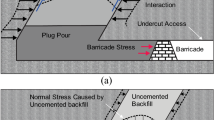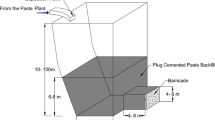Abstract
Deep and high-stress mining results in stress transfers onto the previously placed backfill, and mines have recorded several MPa induced backfill stresses. Understanding the backfill-rock mass interaction is therefore critical. Previous work considered tabular ore bodies undergoing primarily one-dimensional compression and showed how the backfill reaction curves could be estimated from oedometer laboratory test results. This work considers massive orebodies and develops a similar approach based on isotropic compression curves. Isotropic compression tests exceeding 6 MPa are carried out on samples with 3.0 to 11.1% binder content, tested at 1-day cure time to 28-day cure time. The compression curve is characterized in three stages: initial elastic compression up to a yield point, followed by a transition stage to the start of a final stage with a linear post-yield compression line in \(\varepsilon_{v} - \log \left( {p^{\prime } } \right)\) space. Because these isotropic compression tests are rare (the reported results are the first for Cemented Paste Backfill), attempts are made to relate the isotropic compression test parameters to parameters from the more commonly used Unconfined Compression Strength (UCS) tests. Unifying equations as functions of binder content and cure time are found to determine the initial yield stress and the peak strength from UCS tests. These are then related to the corresponding parameters in isotropic compression. Finally, the slope of the post-yield compression line is found as a function of UCS of similar CPB with the same binder content and cure time. Then the isotropic compression behavior of CPB is reconstructed as a function of binder content and curing time using UCS values of similar CPB. Although the calibrated parameters are specific to the studied mine’s materials, the framework is general and applicable to other mines’ CPBs.














Similar content being viewed by others
Data Availability
All data, models, and code generated or used during the study appear in the submitted article.
Abbreviations
- \(B_{i}\) :
-
Constant coefficients
- CC :
-
Cement content
- CT :
-
Curing time
- e :
-
Void ratio at the end of each isotropic consolidation step
- e 0 :
-
Void ratio after curing
- \(\varepsilon_{C}^{v}\) :
-
Total volumetric strain at the end of transitional compression segment
- \(\varepsilon_{Tot}^{v}\) :
-
Total volumetric strain
- \(\varepsilon_{YS}^{v}\) :
-
Total volumetric strain at yield stress
- K :
-
Bulk Modulus
- \(m\) :
-
Intercept of post-yield compression line in \(\varepsilon_{Tot}^{v}\)- \(\log \left( {p^{\prime } } \right)\) space
- \(P_{ISO}\) :
-
Pressure corresponding to the intersection of post-yield compression line and pressure axis
- \(PYCLS\) :
-
Post-yield compression line slope in \(\varepsilon_{Tot}^{v}\)- \(\log \left( {p^{\prime } } \right)\) space
- \(p^{\prime }\) :
-
Effective mean isotropic stress
- \(S_{YS}\) :
-
Slope at yield stress in \(\varepsilon_{Tot}^{v}\)- \(\log \left( {p^{\prime } } \right)\) space
- \(\sigma_{C}\) :
-
Stress at the end of transitional compression segment
- \(\sigma_{YS}^{ISO}\) :
-
Yield stress in isotropic compression test
- \(\sigma_{YS}^{UCS}\) :
-
Yield stress in UCS test
References
Anagnostopoulos AG, Kalteziotis N, Tsiambaos GK, Kavvadas M (1991) Geotechnical properties of the corinth canal marls. J Geotech Geol Eng 9:1–26. https://doi.org/10.1007/BF00880981
ASTM C204-18e1, (2018) STStandard Test Methods for Fineness of Hydraulic Cement by Air-Permeability Apparatus. West Conshohocken, PA, USA
ASTM D4318-05, (2005) Standard Test Methods for Liquid Limit, Plastic Limit, and Plasticity Index of Soils. West Conshohocken, PA, USA
ASTM D5550-14, (2014) Standard Test Method for Specific Gravity of Soil Solids by Gas Pycnometer . West Conshohocken, PA, USA
ASTM (2016) Standard Test Method for Unconfined Compressive Strength of Cohesive Soil. ASTM D2166/D2166M-16, ASTM International, West Conshohocken, PA, USA
Benzaazoua M, Ouellet J, Servant S, Newman P, Verburg R (1999) Cementitious backfill with high sulfur content physical, chemical, and mineralogical characterization. Cem Concr Res 29:719–725. https://doi.org/10.1016/S0008-8846(99)00023-X
Benzaazoua M, Belem T, Bussière B (2002) Chemical factors that influence the performance of mine sulphidic paste backfill. Cem Concr Res 32:1133–1144. https://doi.org/10.1016/S0008-8846(02)00752-4
Benzaazoua M, Belem T, Yilmaz E (2006) Novel lab tool for paste backfill. Can Min J 127:31–33
Bieniawski ZT (1967) Mechanism of brittle fracture of rock: part I—theory of the fracture process. Int J Rock Mech Min Sci Geomech Abstr 4:395–406. https://doi.org/10.1016/0148-9062(67)90030-7
Consoli NC, Casagrande MD, Coop MR (2005) Effect of fiber reinforcement on the isotropic compression behavior of a sand. J Geotech Geoenviron Eng 131:1434–1436. https://doi.org/10.1061/(ASCE)1090-0241(2005)131:11(1434)
Consoli NC, Fonseca AVd, Silva SR, Cruz RC, Fonini A (2012) Parameters controlling stiffness and strength of artificially cemented soils. Géotechnique 62:177–183. https://doi.org/10.1680/geot.8.P.084
Coop MR, Atkinson JH (1993) The mechanics of cemented carbonate sands. Géotechnique 43:53–67. https://doi.org/10.1680/geot.1993.43.1.53
Counter D (2014) Kidd Mine – dealing with the issues of deep and high stress mining – past, present and future. In: Potvin MHaY (ed) Seventh International Seminar on Deep and High Stress Mining, Deep Mining 2014, Sudbury, Canada.
Fang K, Fall M (2020) Shear behavior of the interface between rock and cemented backfill: effect of curing stress, drainage condition and backfilling rate. Rock Mech Rock Eng 53:325–336. https://doi.org/10.1007/s00603-019-01909-2
Fossum AF, Brannon RM (2004) THE SANDIA GEOMODEL: Theory and user’s guide. Sandia National Laboratories Albuquerque, New Mexico and Livermore, California
Foster CD, Regueiro RA, Fossum AF, Borja RI (2005) Implicit numerical integration of a three-invariant, isotropic/kinematic hardening cap plasticity model for geomaterials. Comput Methods Appl Mech Eng 194:5109–5138. https://doi.org/10.1016/j.cma.2005.01.001
Gorakhki MH, Bareither CA (2017) Unconfined compressive strength of synthetic and natural mine tailings amended with fly ash and cement. J Geotech Geoenviron Eng 143:04017017. https://doi.org/10.1061/(ASCE)GT.1943-5606.0001678
Hassani F, Ouellet J, Servant S (2001) In situ measurements in a paste backfill: Backfill and rock mass response in the context of rockburst Paper presented at the 17th International Mining Congress and Exhibition of Turkey IMCET2001, Turkey
Horpibulsuk S, Bergado DT, Lorenzo GA (2004) Compressibility of cement-admixed clays at high water content. Géotechnique 54:151–154. https://doi.org/10.1680/geot.2004.54.2.151
Jafari M, Shahsavari M, Grabinsky M (2020a) Cemented paste backfill 1-D consolidation results interpreted in the context of ground reaction curves. Rock Mech Rock Eng. https://doi.org/10.1007/s00603-020-02173-5
Jafari M, Shahsavari M, Grabinsky M (2020b) Experimental study of the behavior of cemented paste backfill under high isotropic pressure. J Geotechn Geoenviron Eng. https://doi.org/10.1061/(ASCE)GT.1943-5606.0002383
Jafari M, Shahsavari M, Grabinsky M (2020c) Hydration effects on specific gravity and void ratio of cemented paste backfill. Geotech Test J. https://doi.org/10.1520/GTJ20190094
Jafari M, Shahsavari M, Grabinsky M (2021) Drained triaxial compressive shear response of cemented paste backfill (CPB). Rock Mech Rock Eng 54:3309–3325. https://doi.org/10.1007/s00603-021-02464-5
Jafari M, Shahsavari M, Grabinsky M (2017) Cemented Paste Backfill Laboratory study: Sample preparation challenges. In: 70th Canadian Geotechnical Conference and the 12th Joint CGS/IAH-CNC Groundwater Conference- GeoOttawa, Ottawa, Canada
Jefferies M, Been K (2000) Implications for critical state theory from isotropic compression of sand. Géotechnique 50:419–429. https://doi.org/10.1680/geot.2000.50.4.419
Kavvadas M, Papadopoulos B, Kalteziotis N (1994) Geotechnical properties of the Ptolemais lignite. J Geotech Geol Eng 12:87. https://doi.org/10.1007/BF00429768
Kesimal A, Yilmaz E, Ercikdi B (2004) Evaluation of paste backfill mixtures consisting of sulphide-rich mill tailings and varying cement contents. Cem Concr Res 34:1817–1822. https://doi.org/10.1016/j.cemconres.2004.01.018
Kesimal A, Yilmaz E, Ercikdi B, Alp I, Deveci H (2005) Effect of properties of tailings and binder on the short-and long-term strength and stability of cemented paste backfill. Mater Lett 59:3703–3709. https://doi.org/10.1016/j.matlet.2005.06.042
Klein K, Simon D (2006) Effect of specimen composition on the strength development in cemented paste backfill. Can Geotech J 43:310–324. https://doi.org/10.1139/t06-005
Lade PV, Bopp PA (2005) Relative density effects on drained sand behavior at high pressures. J Jap Geotech Soc 45:1–13
Lade PV, Yamamuro JA, Bopp PA (1996) Significance of particle crushing in granular materials. J Geot Eng 122:309–316. https://doi.org/10.1061/(ASCE)0733-9410(1996)122:4(309)
Landriault D (1995) Paste backfill mix design for Canadian underground hard rock mining. In: In 97th Annual Meeting of the C.I.M. Rock Mechanics and Strata Control Session. Westmount, Canada: Canadian Institute of Mining, Metallurgy and Petroleum, Halifax, NS, Canada, pp. 229–238
Li H, Wu A, Wang H (2019) Evaluation of short-term strength development of cemented backfill with varying sulphide contents and the use of additives. J Environ Manage 239:279–286. https://doi.org/10.1016/j.jenvman.2019.03.057
Malandraki V, Toll DG (1996) The definition of yield for bonded materials. J Geotech Geol Eng 14:67–82. https://doi.org/10.1007/BF00431235
Malandraki V, Toll D (2000) Drained probing triaxial tests on a weakly bonded artificial soil. Géotechnique 50:141–151. https://doi.org/10.1680/geot.2000.50.2.141
Malandraki V, Toll DG (2001) Triaxial tests on weakly bonded soil with changes in stress path. J Geotech Geoenviron Eng 127:282–291. https://doi.org/10.1061/(ASCE)1090-0241(2001)127:3(282)
Mitchell RJ, Olsen RS, Smith JD (1982) Model studies on cemented tailings used in mine backfill. Can Geotech J 19:14–28. https://doi.org/10.1139/t82-002
Orejarena L, Fall M (2010) Artificial neural network based modeling of the coupled effect of sulphate and temperature on the strength of cemented paste backfill. Can J Civ Eng 38:100–109. https://doi.org/10.1139/L10-109
Pierce M, Bawden WF, Paynter JT (1998) Laboratory testing and stability analysis of paste backfill at the Golden Giant Mine. In: 6th International Symposium on Mining with Backfill, Minefill ’98, Brisbane, Australia. pp 159–165
Potvin Y, Thomas E, Fourie A (2005) Handbook on Mine Fill. Nedlands, Western Australia: Australian Centre for Geomechanics,
Raffaldi MJ, Seymour JB, Richardson J, Zahl E, Board M (2019) Cemented paste backfill geomechanics at a narrow-vein underhand cut-and-fill mine. Rock Mech Rock Eng 52:4925–4940. https://doi.org/10.1007/s00603-019-01850-4
Rotta GV, Consoli NC, Prietto PDM, Coop MR, Graham J (2003) Isotropic yielding in an artificially cemented soil cured under stress. Géotechnique 53:493–501. https://doi.org/10.1680/geot.2003.53.5.493
Smith PR, Jardine RJ, Hight DW (1992) The yielding of bothkennar Clay. Géotechnique 42:257–274. https://doi.org/10.1680/geot.1992.42.2.257
Thompson BD, Bawden WF, Grabinsky MW (2012) In situ measurements of cemented paste backfill at the Cayeli Mine. Can Geotech J 49:755–772. https://doi.org/10.1139/t2012-040
Thompson BD, Grabinsky MW, Bawden WF, Counter DB (2009) In-situ measurements of cemented paste backfill in long-hole stopes. In: the 3rd CANUS rock mechanics symposium- ROCKENG09, Toronto, Ontario, Canada
Thompson BD, Grabinsky MW, Veenstra R, Bawden WF (2011) In situ pressures in cemented paste backfill—a review of fieldwork from three mines. Paper presented at the 14th International Seminar on Paste and Thickened Tailings, Perth, 5–7 April
Veenstra RL (2013) A Design Procedure for Determining the In Situ Stresses of Early Age Cemented Paste Backfill.
Warren TL, Fossum AF, Frew DJ (2004) Penetration into low-strength (23MPa) concrete: target characterization and simulations. Int J Impact Eng 30:477–503. https://doi.org/10.1016/S0734-743X(03)00092-7
Xu W, Cao P, Tian M (2018) Strength development and microstructure evolution of cemented tailings backfill containing different binder types and contents. Minerals 8:167. https://doi.org/10.3390/min8040167
Yi XW, Ma GW, Fourie A (2015) Compressive behaviour of fibre-reinforced cemented paste backfill. Geotext Geomembranes 43:207–215. https://doi.org/10.1016/j.geotexmem.2015.03.003
Yilmaz E, Belem T, Benzaazoua M, Bussière B (2010) Assessment of the modified CUAPS apparatus to estimate in situ properties of cemented paste backfill. Geotech Test J 33:351–362. https://doi.org/10.1520/GTJ102689
Yilmaz E, Belem T, Bussière B, Mbonimpa M, Benzaazoua M (2015) Curing time effect on consolidation behaviour of cemented paste backfill containing different cement types and contents. Constr Build Mater 75:99–111. https://doi.org/10.1016/j.conbuildmat.2014.11.008
Acknowledgements
The authors wish to express their gratitude to Barrick Gold Corp and Natural Sciences and Engineering Research Council Canada (Collaborative Research and Development Grant #514220-1) for financial support to this research as a part of a larger investigation into the behavior of high-performance cemented paste backfill.
Funding
Barrick Gold Corp and Natural Sciences and Engineering Research Council Canada (Collaborative Research and Development Grant #514220–1).
Author information
Authors and Affiliations
Contributions
MJ developed the experiment strategy, conducted the experiment, interpreted the data, and wrote the manuscript. MG was edited the manuscript. The senior responsible author (SRA) of the publication is MG.
Corresponding author
Ethics declarations
Conflict of interest
The authors declare that they have no conflict of interest.
Additional information
Publisher's Note
Springer Nature remains neutral with regard to jurisdictional claims in published maps and institutional affiliations.
Supplementary Information
Below is the link to the electronic supplementary material.
Rights and permissions
About this article
Cite this article
Jafari, M., Grabinsky, M. Predicting the Isotropic Volumetric Compression Response of Hydrating Cemented Paste Backfill (CPB). Geotech Geol Eng 40, 4821–4836 (2022). https://doi.org/10.1007/s10706-022-02186-7
Received:
Accepted:
Published:
Issue Date:
DOI: https://doi.org/10.1007/s10706-022-02186-7




